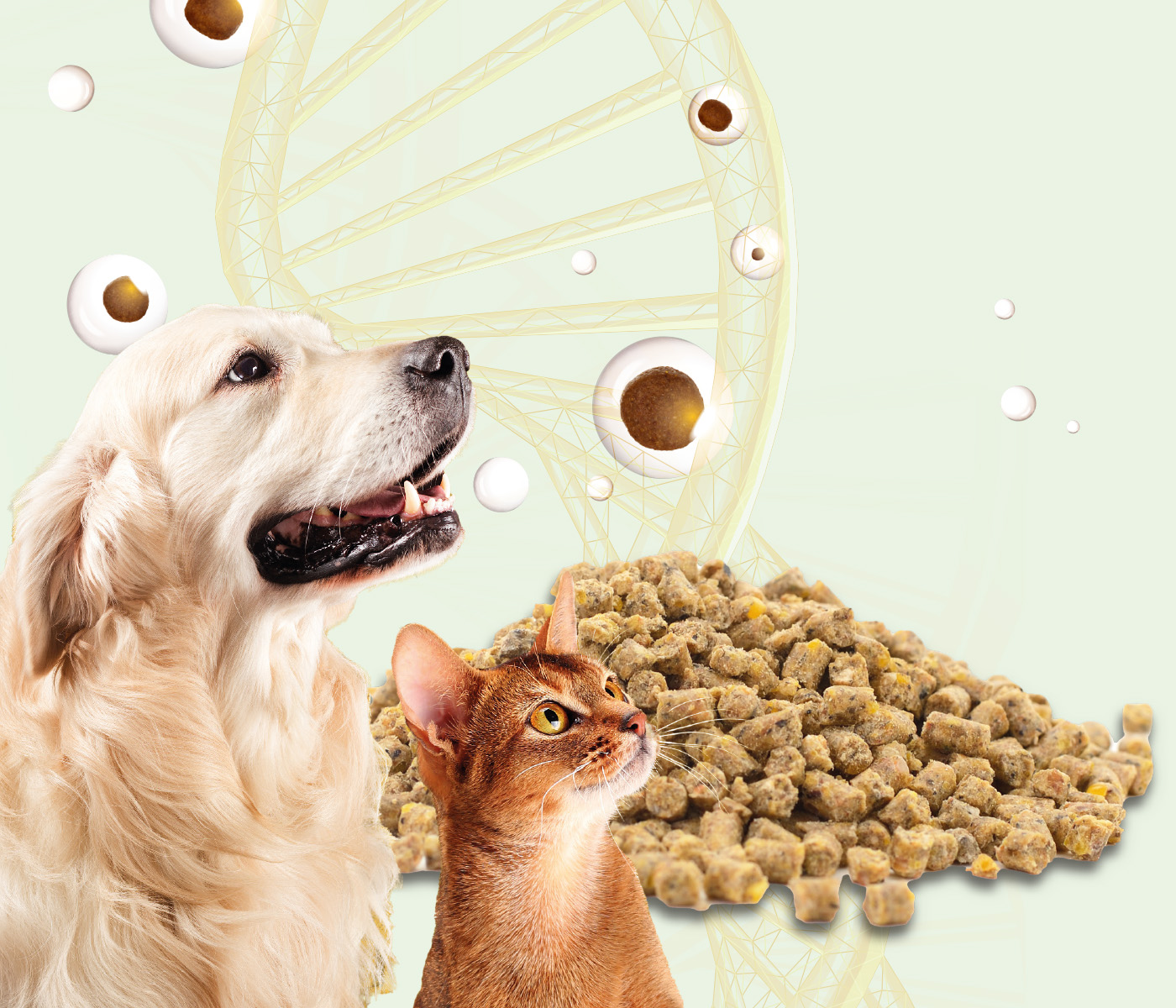Nutraceuticals in the diet of dogs and cats
Proper nourishment of dogs and cats is the basis for a healthy and long-lasting life. To meet this premise, nutritionists develop diets based on data regarding nutritional requirements for amino acids, fatty acids, minerals and vitamins. Associated with the energy needs of different physiological phases. While also consulting recommendations found in different databases and nutritional guidelines for dogs and cats, such as: FEDIAF, NRC or AAFCO.
Nutrient requirements and their availability in different ingredients is related to the digestibility of raw materials, which can be influenced by:
- Antinutritional factors
- Levels and types of fibers
- Quality of diet processing
- Intestinal health and other factors

Knowledge and application of this nutritional basis is essential. However, with genetic mapping it is possible to have access to new information related to the interaction which occurs between ingredient compounds and genes. This new discipline is known as nutritional genomics which evaluates the effects of nutrients and bioactive components of the diet on gene expression. Nutrigenetics, evaluates genetic variation of individuals and the effects that these changes have on the individual’s response towards the diet.
Understanding the gene/nutrient interaction is important for nutritional support in dogs and cats. Considering the fact that nutrients as well as bioactive and phytochemical compounds can modify the animal’s phenotype through gene expression modulation.
 Understanding these interactions directly in the gene or through epigenetic relationships allows to select those nutritional components that are the most beneficial for the animal’s health. Transforming the development of diets, focusing on the balance of the individual as a whole,and reducing the risk of disease.
Understanding these interactions directly in the gene or through epigenetic relationships allows to select those nutritional components that are the most beneficial for the animal’s health. Transforming the development of diets, focusing on the balance of the individual as a whole,and reducing the risk of disease.
Certain diseases will benefit more from nutrigenomic studies. Some examples are: chronic degenerative diseases related to oxidative stress, chronic inflammations, imbalances in the endocannabinoid and metabolic systems.
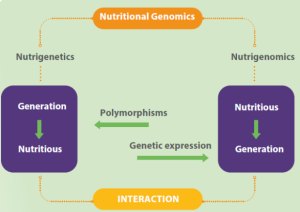
The living standards for dogs and cats in today’s society are completely different from what they were a few decades back. Many have little or no physical activity during long periods of time and are sometimes confined to very small spaces. Some individuals suffer from separation anxiety while many of their tutors have a hard time understanding that the behavioral and nutritional needs of dogs and cats are different from those of humans. Which in many cases leads them to establish stressful environments for their pets to live in.
Changing diets based on individual profiles is promising, but a change in the lifestyle of these animals is also necessary. Considering that the environment as a whole can modulate gene expression.

The feed component contributes largely to modulating animal health. This has been verified as the life expectancy of dogs and cats has doubled in recent years and the use of dietary components such as functional and nutraceutical foods has shown to contribute to healthy aging.
Functional foods must present bioactive or phytochemical compounds, as well a beneficial properties in addition to their basic nutritional characteristics. Nutraceuticals are isolated bioactive compounds, which are found in concentrated forms, superior to those present in foods.
Both can be beneficial for organic functions within the body of dogs and cats. Reducing the risk of disease, and in the case of nutraceuticals, these can be used as supplements of certain treatments.
Japan was responsible for the introduction of these concepts of food functionality during the 1980s. In 1990, foods known as Foods for Specified Health Use (FOSHU) were created, aiming to promote health within the population (Anjo, 2004).
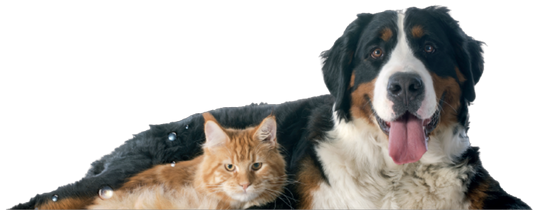
Compounds and actions of nutraceuticals
Antioxidants
Free radicals are produced as part of the body’s normal functioning through various metabolic reactions and in response to chemical or biological stressors.

Reactive oxygen species in free radicals are highly unstable due to the unique shape of their electrons, which need to donate or capture new ones in order to reach an equilibrium. This process leads to protein, DNA and cell damage.
These harmful effects must be neutralized in order to prevent destruction or loss of cellular function and tissues. However, due to the high frequency with which challenges occur, existing oxidizing systems may not be enough to avoid the onset of oxidative stress. Resulting in premature aging (Eirmann, 2017).
- The use of antioxidant nutraceuticals can help the body in combating free radicals, and reducing their deleterious effects on the body of dogs and cats.
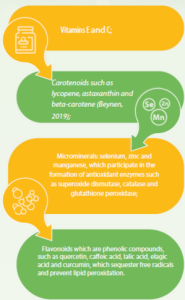
It is worth highlighting that besides their antioxidant capacity, many of the aforementioned compounds carry out protective actions. Such as: renal protection, protective effects in cardiovascular and hepatic systems, as well as having anti-inflammatory and anticarcinogenic actions (Dornas et. al., 2007).
Polyunsaturated fatty acids and omega 3

These are found in cold water marine fish and are considered to be essential nutrients (NRC, 2006). Through alpha-linolenic fatty acids and the actions of the enzymes desaturase and elongase, they synthesize eicosapentaenoic acids (EPA) and docosahexaenoic acids (DHA).
However, in dogs this action is limited while in cats it simply does not occur. Therefore,these molecules must be supplemented in order maintain physiological activities like: cell signaling, fluidity and integrity of cell membranes (Calder, 2008).
The omega 3 family have several important actions, amongst which some examples are:
- Modulation of inflammatory processes through the synthesis of anti-inflammatory cytokines (Calder, 2012);
- Cardioprotective, neurological and allergic processes
- Cancer prevention
- Improvement of renal function
- Skin and coat health among other protective actions.
Probiotics and prebiotics
They are used in order to assist in the modulation of the intestinal microbiota, improving the profile of desirable microorganisms and controlling those with pathogenic potential.
Probiotics are living microorganisms that, when supplemented, contribute to the reestablishment and the maintenance of microbiota eubiosis.
Prebiotics are mostly non-digestible oligosaccharides. Yet, these are fermentable by desirable microorganisms, which contributes to improving and balancing their populations. While reducing pathogenic bacteria populations. The presence of short-chain fatty acids is necessary for the maintenance of intestinal cells and serves as a substrate for the growth of healthy microbiota.
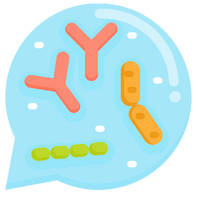
The main prebiotics which are used as supplements in small animal diets are: fructooligosaccharides, mannan-oligosaccharides, β-glucans and inulin.
The dog and cat microbiota is specific to each individual. It is known that phylums in dogs have higher percentages of Firmicutes, followed by Proteobacteria, Fusobacteria, Bacteroidetes, and Actinobacteria, respectively. However, factors such as lifestyle, diet, genetics and physiological state can affect the composition of microbial populations.
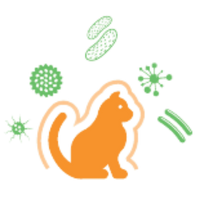
The importance of a balanced microbiota, is associated with good health, as it contributes to preserving intestinal integrity. The latter is key when strengthening the immune system (Zapatera et. al., 2015).
Regarding the modulation of the immune system through the stimulation of cellular and humoral immunity, β-glucans stand out. These compounds contribute to reducing inflammatory responses, and possess antibacterial, antitumor and antiviral activities(Vannucci & Vetvicka, 2019).
Final Considerations

The use of nutraceuticals in dogs and cats has become a growing trend. Some studies have shown that there are health benefits when these compounds are associated with well-formulated diets, as well as proving that they can be used as supplements for disease treatment and prevention.
However, there is still very little species-specific information, and further clarification regarding dosage and efficacy levels is required.
Source: This article was originally published as a portuguese content in Nutrinews Brasil 4th Trimester 2022
Bibliographical References:
Angel, D. L.C. Functional foods in angiology and vascular surgery. Jornal Vascular Brasileiro. v. 3, n. 2, p. 145- 154, 2004.
Beyben, A.C. Carotenoides in petfood. Creature Companion, December: 40-41, 2019.
Calder, P. C. The relationship between the fatty acid composition of immune cells and their function. Prostaglandins Leukotrienes & Essential Fatty Acids, Edinburgh, v. 79, n. 3-5, p. 101-108, set./nov. 2008.
Calder, P. C. Long-chain fatty acids and inflammation, Proc. Nutr. Soc., v. 71 (2), p. 284-9, may. 2012.
Dornas WC, Oliveira TT, Rodrigues-das-Dores RG, Santos AF, Nagem TJ. Flavonoids: therapeutic potential in oxidative stress. Rev Ciênc Farm Basic Apl 2007;28(3):241-249.
Eirmann, L. Antioxidants, Nutraceuticals, Probiotics, and Nutritional Supplement In: Ettinger, S.J., Feldman, E.C., Côté, E. Textbook of Veterinary Internal Medicine. 8° edition, 2017
Vannucci, L E Vetvicka, V. Glucan and its role in immunonutrition. Nutrition and Immunity, 2019.
Zapatera, B. Prados, A., Gómez-Martínez, S. and Marcos, S. Immunonutrition: methodology and applications. Nutr Hosp. 2015;31(Supl. 3):145-154.
